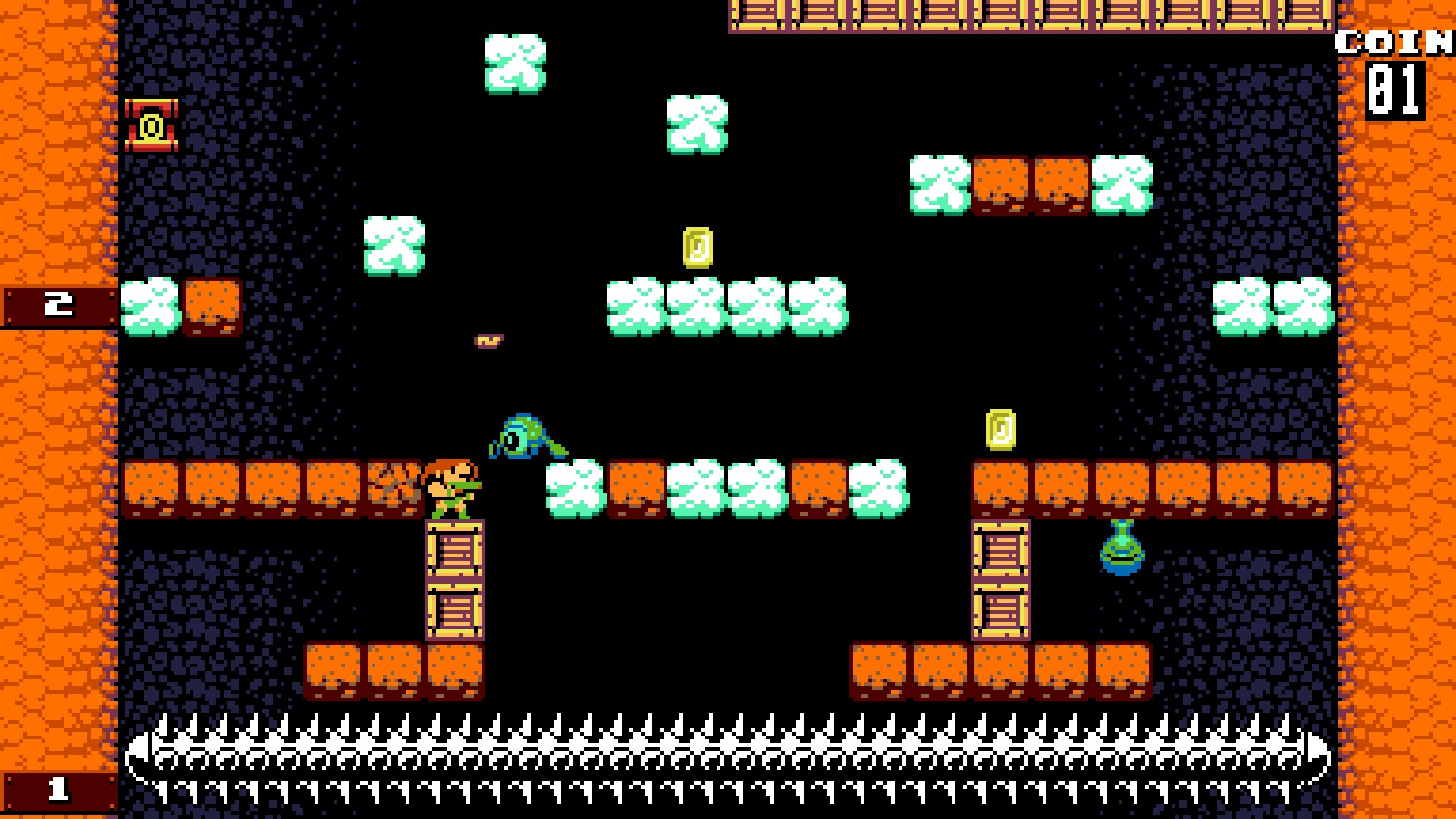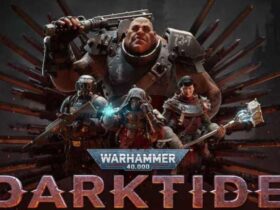After eight years in development from an all-star team of indie devs, UFO 50 is finally here: a collection of 50 games encompassing the library of a fictional 8-bit video game console from the ’80s. With a massive selection of games coincidentally spread across eight years of in-universe development, what better way to celebrate UFO 50’s excellence in 2024 than by deciding which of its games would’ve earned Game of the Year awards at their supposed original release?
I’ll start this with the caveat that I have definitely not finished every game in UFO 50 – that’s a multi-hundred-hour time investment that I haven’t been able to manage in this, the year of hundred-hour JRPGs. But I have played each game long enough to at least complete the achievement that adds its gift item to the main menu’s virtual pet garden, which is just about enough time to at least understand what every title has to offer.
UFO 50’s fictional chronology spans from 1982 through 1989, and I’ve chosen a Game of the Year winner for each of those years. If you’re not the sort to be immediately mesmerized by weird retro games, working your way chronologically through UFO 50 is probably going to be a bad time, so consider this a list of highlights to check out so you know what the collection has to offer at its very best. Plus, stick around for a few extra picks at the end because I just can’t shut up about this game.
Best game of 1982 – Barbuta

In 1982 there’s only one option, which means there’s only one choice – but Barbuta would be a standout even if UFO Soft had actually released other games that year. This is a tough-as-nails puzzle platformer that evokes the inscrutable action-adventure games that dominated the European PC gaming scene of the ’80s. Thankfully, it equally evokes the joy that comes with solving those nightmarish puzzles and discovering new paths through an unforgiving labyrinth. Barbuta is as old-school as it gets, and a perfect note for UFO 50 to start on. If it doesn’t scare players away entirely, anyway.
Best game of 1983 – Ninpek

There’s a purity to ’80s arcade action games that can’t be beat, and Ninpek is as pure as it gets. You’re a ninja running from left to right armed with nothing but some short-range throwing stars, and you’ve got to navigate a gauntlet of weird little monsters and auto-scrolling platforming challenges to reach the end of the game and set a high score. The controls are pitch-perfect – you won’t find a double-jump that feels this good in a legit 1983 platformer – and the unique scoring system where you’ve got to collect eggs dropped by defeated enemies makes the score chase exciting over many, many runs.
Best game of 1984 – Mortol

While the earliest games in UFO 50 feel like great little tributes to old-school gaming, Mortol is the first game that feels fully unique, and the first truly excellent game in the collection. You start with 20 lives as you try to make it to the end of a platforming level. The trick is that the bodies from all your previous runs stay on the course as you keep playing, and you can sacrifice each life in various ways to blow up obstacles, take out enemies, or create new paths toward the end. There are limited opportunities to get more lives, and your best life counter in each level carries forward to the next, meaning that you’ll have a much easier time completing later levels if you go for better runs in the early stages. It’s a puzzle platformer by way of Lemmings, and an endlessly compelling one at that.
Best game of 1985 – Mooncat

I’ve seen the end of Mooncat and I’m still not sure I truly ‘get’ it, but damn if I’m not compelled all the same. This would be no more than a solid platformer with bizarre alien mushroom aesthetics if not for the bizarre control scheme, where one button makes you go left, the other makes you go right, and tapping both together lets you jump. You have to rewire your brain a little to make sense of it, but once it starts to click, the rhythm of the action and strategy of planning your route among all the enemies and obstacles can tickle your baser gaming senses like little else.
Best game of 1986 – Party House

If there’s a frontrunner for ‘best game in UFO 50’ by pure consensus, it’s probably Party House. Heck, even Derek Yu called it out as a favorite when I interviewed him earlier this year. It’s a deckbuilder where your “deck” is a Rolodex full of people who might show up to your party. Some will add to your popularity stat, which you can spend to recruit more new friends, while others will give cash that you can use to upgrade your house to hold more partygoers. The richest and most popular invitees are also likely to bring trouble with them, and if three troublemakers enter your party, the cops show up and clear everyone out before you can get your rewards. Within a limited number of rounds, you’ve got to set up a winning deck to get a handful of specific partygoers in the house at once, trying to build up big payouts while mitigating the risk of too many troublemakers showing up at once. Each run is super-quick, and slowly figuring out the optimal build for a winning effort is great fun.
Best game of 1987 – Vainger

An old-school Metroidvania with ’80s cyberpunk anime aesthetics, wild platforming mechanics, and a unique upgrade system to boot? Look, I would’ve paid $25 for Vainger even if it didn’t come with 49 other games. Taking a page from NES cult classic Metal Storm, you can flip gravity at any time to start walking on ceilings and turn the platforming upside down, which leads to a lot of creative stage design you’ve got to puzzle your way through. Upgrades are multipurpose tools you can apply to different parts of your kit at terminals throughout the game, so you might use a flame upgrade to turn your gun into a flamethrower that can destroy fuel barrels blocking your path, then shortly after move the same item to your body armor to give you the fire resistance you need to get through a hot area. It adds an extra layer to the traditional Metroidvania upgrade progression, adding to a unique take on a familiar retro formula.
Best game of 1988 – Valbrace

Adding Punch-Out-style action combat to an old-school dungeon crawler is such a left-field idea that it feels like it shouldn’t work, but Valbrace reaches levels of peanut butter and jelly-like perfection that should not be possible. This is a first-person dungeon crawler in the most traditional sense, where you’ve got to survive a grueling labyrinth filled with monsters as you search every corner for items and equipment that’ll give you an edge in the fights to come. The twist is that once you get into a fight, the combat is all real-time, leaving you to dodge and block while trying to find the hole in each enemy’s attack pattern. It gets even better when you add in a magic system that challenges you to quickly draw the glyphs that call forth your spells, bringing another level of consideration to the fights. This is just a fantastic action twist on a familiar format, and I think Valbrace might just be my favorite game in the entire package.
Best game of 1989 – Mini & Max

The most reliable concept for a great video game level is to let you sometimes be big, and sometimes be small. Mini & Max is here to prove that you can build a whole game around the idea. You start in a tiny room with a few shelves you can jump on, but by holding the D-pad down for a couple of seconds, you’ll enter a miniature world full of bugs to fight and books to clamber up. You can grab items and enemies Mario 2-style, and they’ll shrink or grow with you as you enter the big and small worlds – which means you might need to carry, say, a butterfly from one end of the map to the other in order to float across an otherwise impassable gap. It’s a great little puzzle platformer.
But eight games is just not enough to pick through UFO 50’s highlights, so I’ve also put together a few runners-up – one from each category on the main catalog menu. Also, if you like horror games and point-and-click adventures, play Night Manor. It’s the one massive highlight I couldn’t fit within my arbitrary guidelines for this post, but you should play Night Manor.
Best Epic Play – Grimstone

With the name of this category being “epic play,” there could really be no choice other than Grimstone. This is an old-school JRPG in the vein of the original Final Fantasy or Dragon Quests, but set in a sort of Weird West underworld. You’ll grind for cash and XP, gain levels and buy items, and then challenge a dungeon before repeating the process around a new town. This formula has stood the test of time for a reason, and Grimstone ups the ante with a timing-based combat system that keeps the battles engaging. Plus the party-building system at the start of the adventure is one of the best cruel game design tricks I’ve ever seen: you choose your characters not by their stats or abilities, but by who you want to save from dying inside a burning saloon. We’ve all got the dog in our party, right?
Best Quick Play – Velgress

“What if Downwell, but up?” is the kind of question that’s only going to make sense to a certain kind of indie roguelike sicko, but Velgress maintains just the kind of action – harrowing, yet mesmerizing – that made that other vertical shooter such a cult hit. You need to climb a tower, but every platform you jump on will crumble underneath you, and as you rise up the levels a deadly trap will constantly sit just below, waiting for you to make a mistake. You’ve got to constantly split your focus between shooting enemies, clearing a path for yourself, making sure your footing is safe, and grabbing coins you can spend on upgrades between stages. Runs are very short – a successful bid to reach the ending takes less than ten minutes – but they keep you coming back.
Best Thinky Play – Rock On! Island

Y’all like tower defense? What about tower defense with dinosaurs? Rock On! Island is a familiar take on the genre aside from its caveman aesthetics and cute pixel art, but that doesn’t make it any less compelling. You’ll need a lot of trial and error to figure out the best unit placement to conquer each stage, but the combination possibilities keep it fun. The best bit is the campfire mechanic, where you can drop fires to power up nearby units – and cook the chickens you need to farm food and buy more defensive soldiers. I never thought I’d get obsessed with optimal chicken placement in a tower defense game, but that’s the magic of Rock On! Island.
Best Reflex Play – Campanella 3

Campanella 3 is a faux-3D space shooter that plays a bit like a sprite-based take on Star Fox. The gimmick is that any enemies that you fail to shoot as they fly toward you will suddenly become obstacles in the 2D space around your ship. You can shoot in front of you and to the sides, so you’ve got to keep enemies clear from all directions, shifting shooting styles as each new target comes in. Shooting down every enemy in a given wave gives you a leg-up in the bonus round that lets you earn extra lives, and memorizing the full enemy patterns keeps repeated runs through the stages exciting.
If you’re looking for a more modern celebration, here’s our full list of the best games of 2024.











Leave a Reply